Care Coordination in Nursing Practice for Liam's Shared Care Plan
VerifiedAdded on 2022/12/29
|9
|2827
|39
AI Summary
This report discusses the role of registered nurses as complex care coordinators in managing Liam's shared care plan. It identifies the facilities, organizations, and professionals involved in Liam's treatment goals and explores the barriers to achieving these goals. The report also outlines the necessary care coordination skills and strategies for effectively implementing Liam's shared care plan.
Contribute Materials
Your contribution can guide someone’s learning journey. Share your
documents today.
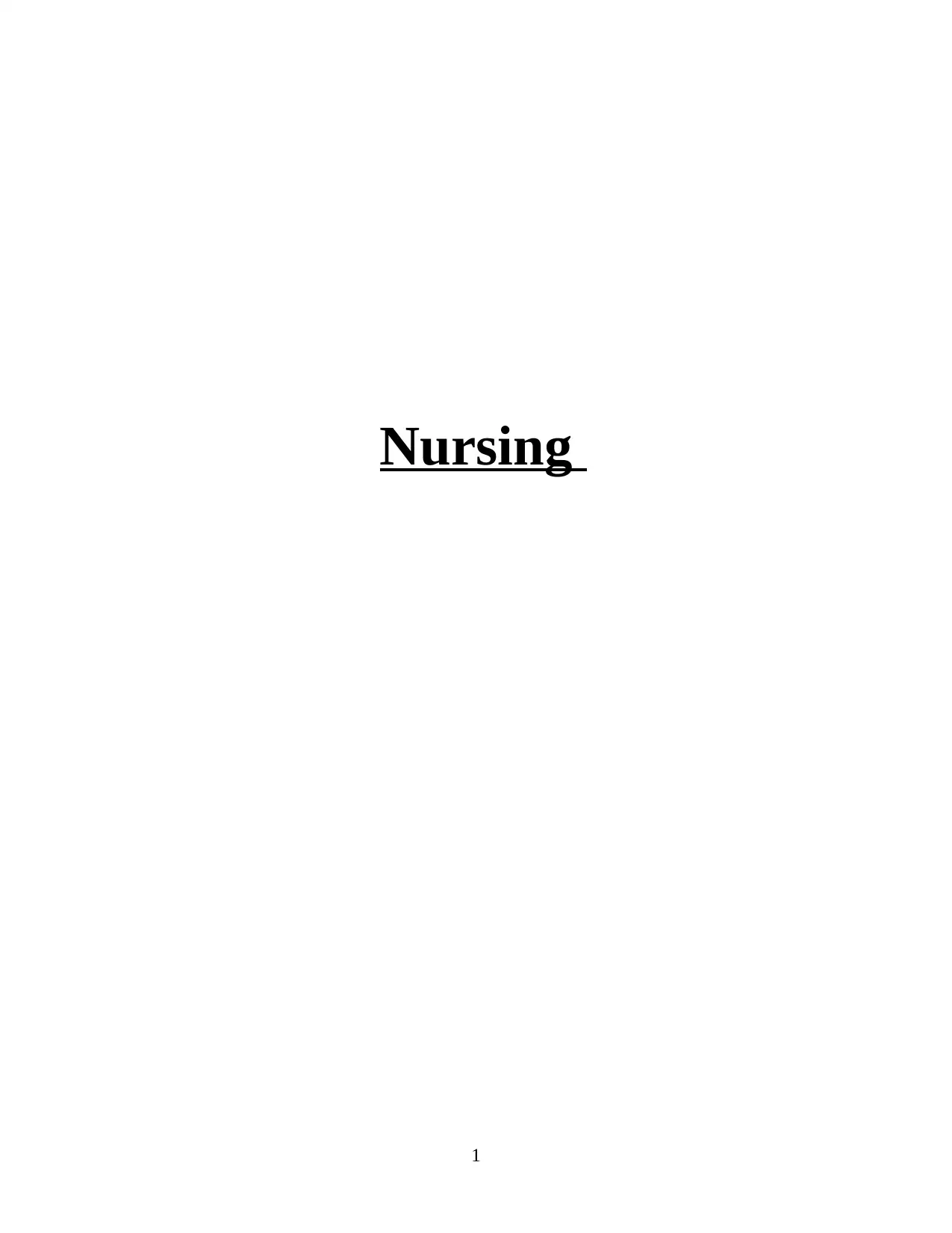
Nursing
1
1
Secure Best Marks with AI Grader
Need help grading? Try our AI Grader for instant feedback on your assignments.
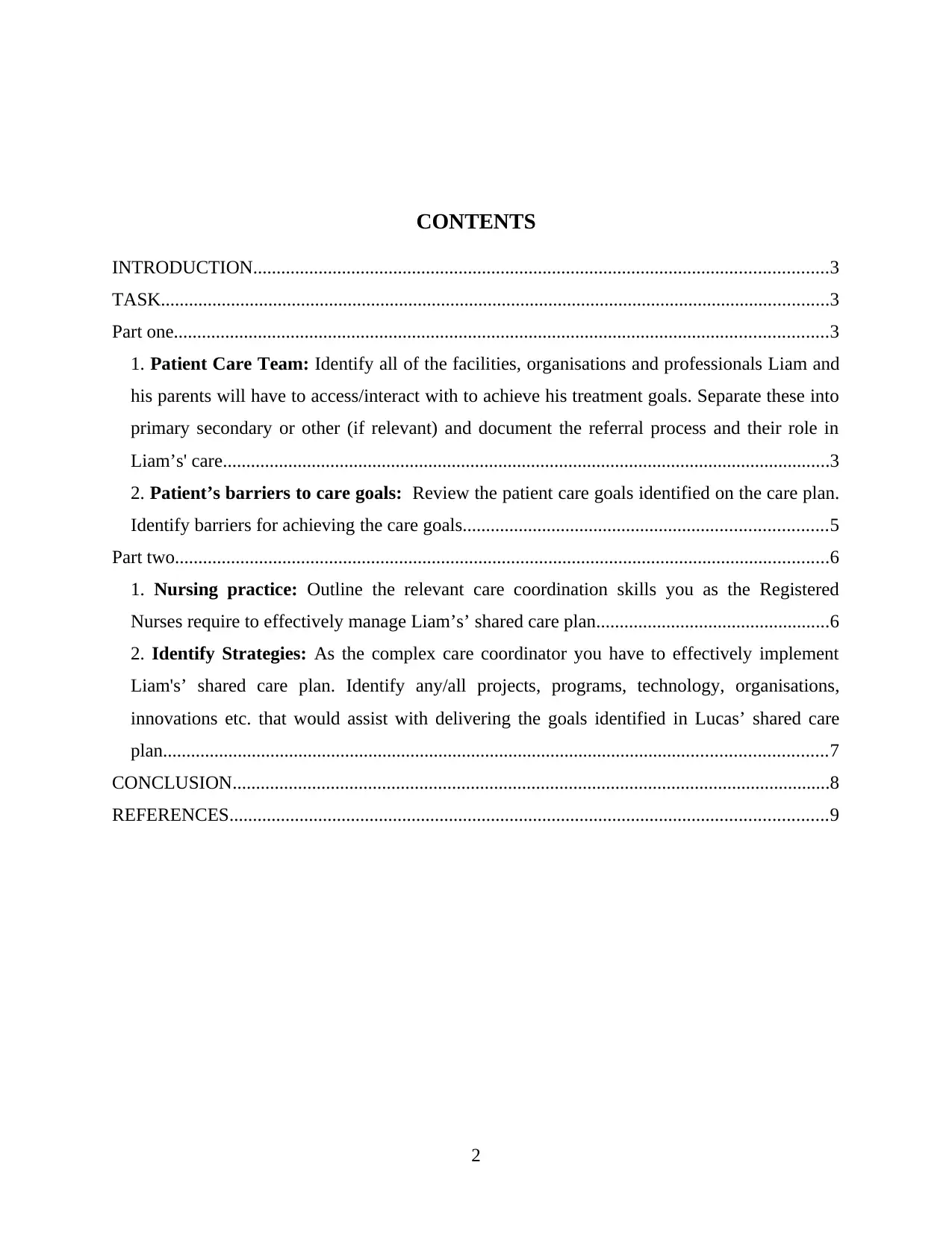
CONTENTS
INTRODUCTION...........................................................................................................................3
TASK...............................................................................................................................................3
Part one............................................................................................................................................3
1. Patient Care Team: Identify all of the facilities, organisations and professionals Liam and
his parents will have to access/interact with to achieve his treatment goals. Separate these into
primary secondary or other (if relevant) and document the referral process and their role in
Liam’s' care..................................................................................................................................3
2. Patient’s barriers to care goals: Review the patient care goals identified on the care plan.
Identify barriers for achieving the care goals..............................................................................5
Part two............................................................................................................................................6
1. Nursing practice: Outline the relevant care coordination skills you as the Registered
Nurses require to effectively manage Liam’s’ shared care plan..................................................6
2. Identify Strategies: As the complex care coordinator you have to effectively implement
Liam's’ shared care plan. Identify any/all projects, programs, technology, organisations,
innovations etc. that would assist with delivering the goals identified in Lucas’ shared care
plan..............................................................................................................................................7
CONCLUSION................................................................................................................................8
REFERENCES................................................................................................................................9
2
INTRODUCTION...........................................................................................................................3
TASK...............................................................................................................................................3
Part one............................................................................................................................................3
1. Patient Care Team: Identify all of the facilities, organisations and professionals Liam and
his parents will have to access/interact with to achieve his treatment goals. Separate these into
primary secondary or other (if relevant) and document the referral process and their role in
Liam’s' care..................................................................................................................................3
2. Patient’s barriers to care goals: Review the patient care goals identified on the care plan.
Identify barriers for achieving the care goals..............................................................................5
Part two............................................................................................................................................6
1. Nursing practice: Outline the relevant care coordination skills you as the Registered
Nurses require to effectively manage Liam’s’ shared care plan..................................................6
2. Identify Strategies: As the complex care coordinator you have to effectively implement
Liam's’ shared care plan. Identify any/all projects, programs, technology, organisations,
innovations etc. that would assist with delivering the goals identified in Lucas’ shared care
plan..............................................................................................................................................7
CONCLUSION................................................................................................................................8
REFERENCES................................................................................................................................9
2
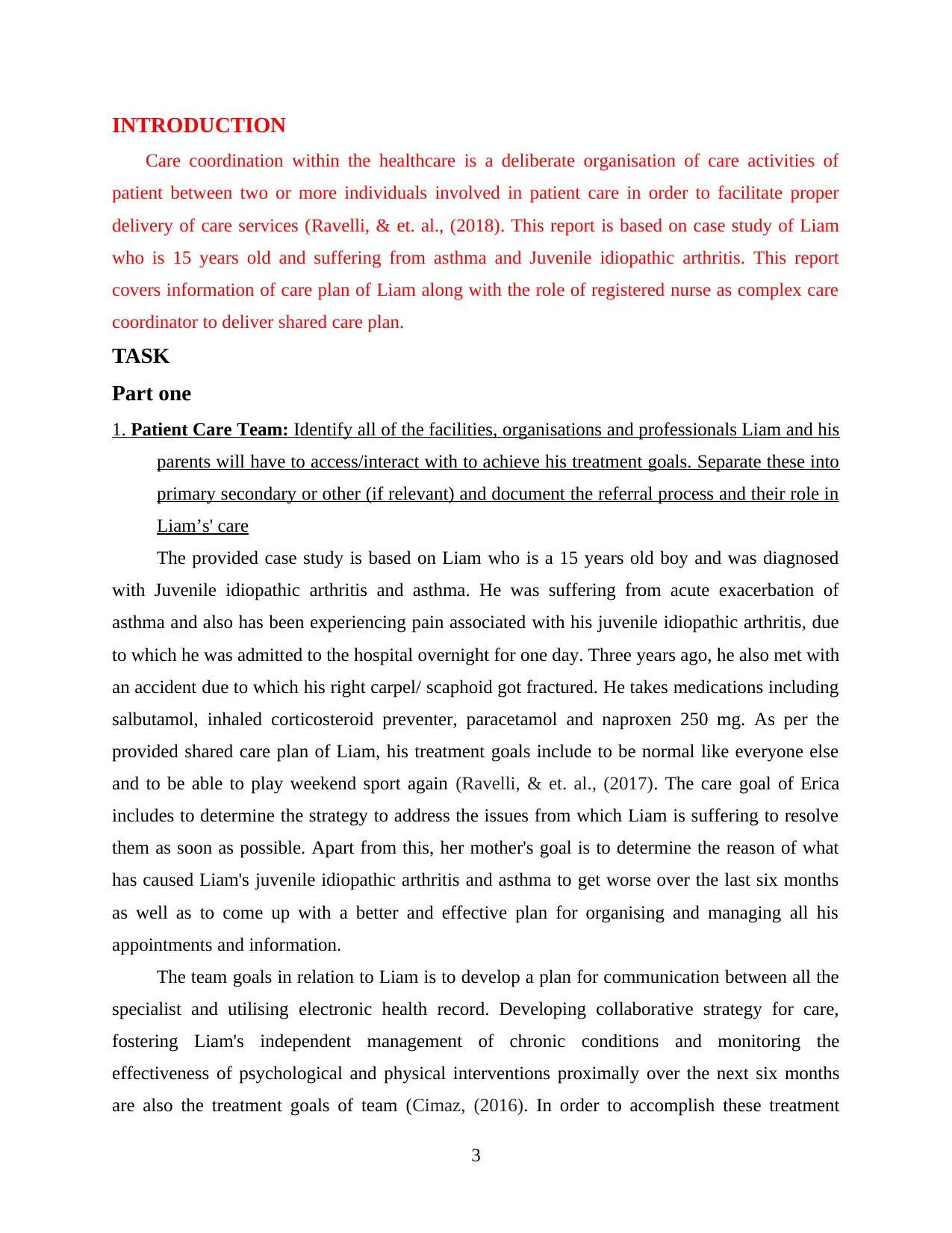
INTRODUCTION
Care coordination within the healthcare is a deliberate organisation of care activities of
patient between two or more individuals involved in patient care in order to facilitate proper
delivery of care services (Ravelli, & et. al., (2018). This report is based on case study of Liam
who is 15 years old and suffering from asthma and Juvenile idiopathic arthritis. This report
covers information of care plan of Liam along with the role of registered nurse as complex care
coordinator to deliver shared care plan.
TASK
Part one
1. Patient Care Team: Identify all of the facilities, organisations and professionals Liam and his
parents will have to access/interact with to achieve his treatment goals. Separate these into
primary secondary or other (if relevant) and document the referral process and their role in
Liam’s' care
The provided case study is based on Liam who is a 15 years old boy and was diagnosed
with Juvenile idiopathic arthritis and asthma. He was suffering from acute exacerbation of
asthma and also has been experiencing pain associated with his juvenile idiopathic arthritis, due
to which he was admitted to the hospital overnight for one day. Three years ago, he also met with
an accident due to which his right carpel/ scaphoid got fractured. He takes medications including
salbutamol, inhaled corticosteroid preventer, paracetamol and naproxen 250 mg. As per the
provided shared care plan of Liam, his treatment goals include to be normal like everyone else
and to be able to play weekend sport again (Ravelli, & et. al., (2017). The care goal of Erica
includes to determine the strategy to address the issues from which Liam is suffering to resolve
them as soon as possible. Apart from this, her mother's goal is to determine the reason of what
has caused Liam's juvenile idiopathic arthritis and asthma to get worse over the last six months
as well as to come up with a better and effective plan for organising and managing all his
appointments and information.
The team goals in relation to Liam is to develop a plan for communication between all the
specialist and utilising electronic health record. Developing collaborative strategy for care,
fostering Liam's independent management of chronic conditions and monitoring the
effectiveness of psychological and physical interventions proximally over the next six months
are also the treatment goals of team (Cimaz, (2016). In order to accomplish these treatment
3
Care coordination within the healthcare is a deliberate organisation of care activities of
patient between two or more individuals involved in patient care in order to facilitate proper
delivery of care services (Ravelli, & et. al., (2018). This report is based on case study of Liam
who is 15 years old and suffering from asthma and Juvenile idiopathic arthritis. This report
covers information of care plan of Liam along with the role of registered nurse as complex care
coordinator to deliver shared care plan.
TASK
Part one
1. Patient Care Team: Identify all of the facilities, organisations and professionals Liam and his
parents will have to access/interact with to achieve his treatment goals. Separate these into
primary secondary or other (if relevant) and document the referral process and their role in
Liam’s' care
The provided case study is based on Liam who is a 15 years old boy and was diagnosed
with Juvenile idiopathic arthritis and asthma. He was suffering from acute exacerbation of
asthma and also has been experiencing pain associated with his juvenile idiopathic arthritis, due
to which he was admitted to the hospital overnight for one day. Three years ago, he also met with
an accident due to which his right carpel/ scaphoid got fractured. He takes medications including
salbutamol, inhaled corticosteroid preventer, paracetamol and naproxen 250 mg. As per the
provided shared care plan of Liam, his treatment goals include to be normal like everyone else
and to be able to play weekend sport again (Ravelli, & et. al., (2017). The care goal of Erica
includes to determine the strategy to address the issues from which Liam is suffering to resolve
them as soon as possible. Apart from this, her mother's goal is to determine the reason of what
has caused Liam's juvenile idiopathic arthritis and asthma to get worse over the last six months
as well as to come up with a better and effective plan for organising and managing all his
appointments and information.
The team goals in relation to Liam is to develop a plan for communication between all the
specialist and utilising electronic health record. Developing collaborative strategy for care,
fostering Liam's independent management of chronic conditions and monitoring the
effectiveness of psychological and physical interventions proximally over the next six months
are also the treatment goals of team (Cimaz, (2016). In order to accomplish these treatment
3
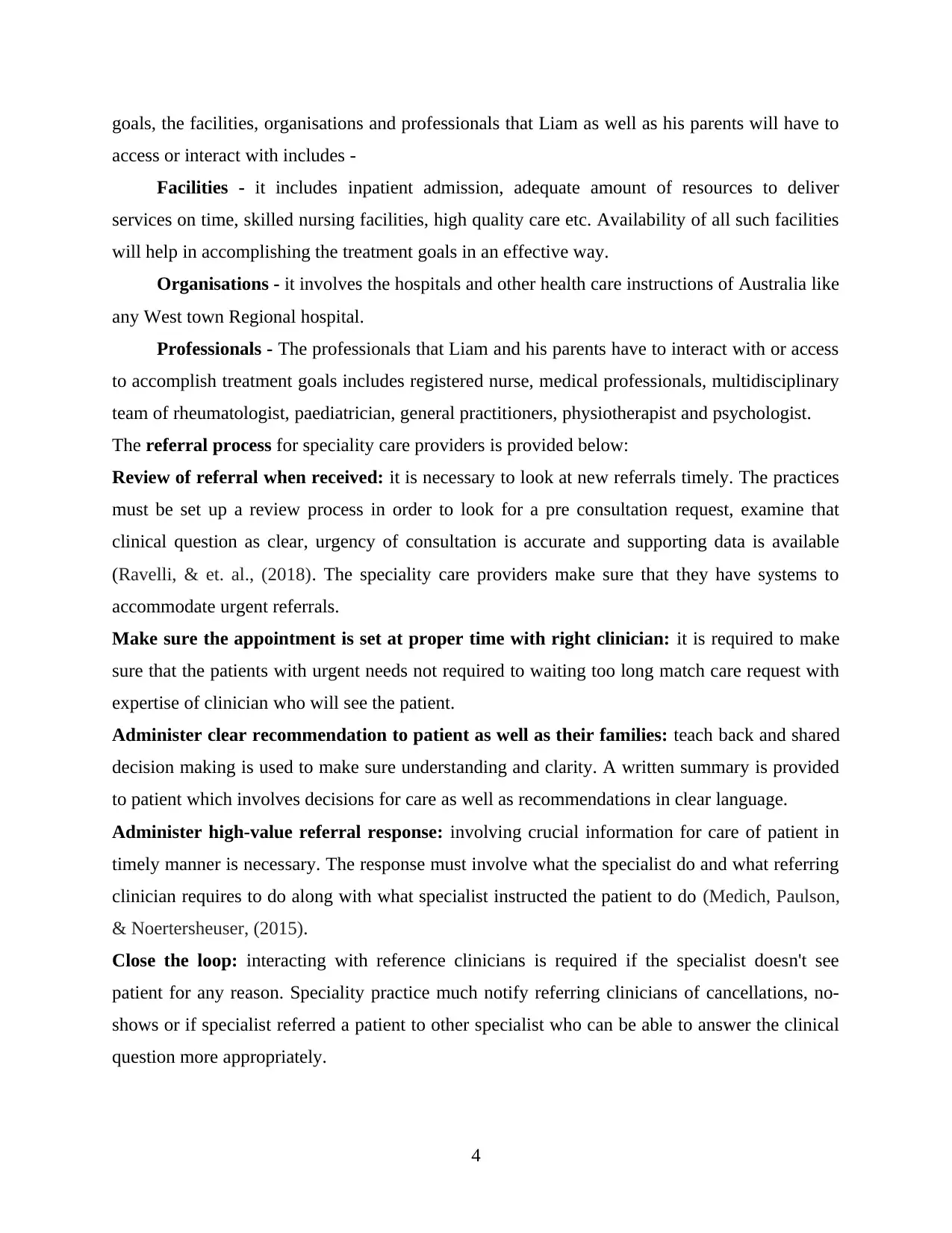
goals, the facilities, organisations and professionals that Liam as well as his parents will have to
access or interact with includes -
Facilities - it includes inpatient admission, adequate amount of resources to deliver
services on time, skilled nursing facilities, high quality care etc. Availability of all such facilities
will help in accomplishing the treatment goals in an effective way.
Organisations - it involves the hospitals and other health care instructions of Australia like
any West town Regional hospital.
Professionals - The professionals that Liam and his parents have to interact with or access
to accomplish treatment goals includes registered nurse, medical professionals, multidisciplinary
team of rheumatologist, paediatrician, general practitioners, physiotherapist and psychologist.
The referral process for speciality care providers is provided below:
Review of referral when received: it is necessary to look at new referrals timely. The practices
must be set up a review process in order to look for a pre consultation request, examine that
clinical question as clear, urgency of consultation is accurate and supporting data is available
(Ravelli, & et. al., (2018). The speciality care providers make sure that they have systems to
accommodate urgent referrals.
Make sure the appointment is set at proper time with right clinician: it is required to make
sure that the patients with urgent needs not required to waiting too long match care request with
expertise of clinician who will see the patient.
Administer clear recommendation to patient as well as their families: teach back and shared
decision making is used to make sure understanding and clarity. A written summary is provided
to patient which involves decisions for care as well as recommendations in clear language.
Administer high-value referral response: involving crucial information for care of patient in
timely manner is necessary. The response must involve what the specialist do and what referring
clinician requires to do along with what specialist instructed the patient to do (Medich, Paulson,
& Noertersheuser, (2015).
Close the loop: interacting with reference clinicians is required if the specialist doesn't see
patient for any reason. Speciality practice much notify referring clinicians of cancellations, no-
shows or if specialist referred a patient to other specialist who can be able to answer the clinical
question more appropriately.
4
access or interact with includes -
Facilities - it includes inpatient admission, adequate amount of resources to deliver
services on time, skilled nursing facilities, high quality care etc. Availability of all such facilities
will help in accomplishing the treatment goals in an effective way.
Organisations - it involves the hospitals and other health care instructions of Australia like
any West town Regional hospital.
Professionals - The professionals that Liam and his parents have to interact with or access
to accomplish treatment goals includes registered nurse, medical professionals, multidisciplinary
team of rheumatologist, paediatrician, general practitioners, physiotherapist and psychologist.
The referral process for speciality care providers is provided below:
Review of referral when received: it is necessary to look at new referrals timely. The practices
must be set up a review process in order to look for a pre consultation request, examine that
clinical question as clear, urgency of consultation is accurate and supporting data is available
(Ravelli, & et. al., (2018). The speciality care providers make sure that they have systems to
accommodate urgent referrals.
Make sure the appointment is set at proper time with right clinician: it is required to make
sure that the patients with urgent needs not required to waiting too long match care request with
expertise of clinician who will see the patient.
Administer clear recommendation to patient as well as their families: teach back and shared
decision making is used to make sure understanding and clarity. A written summary is provided
to patient which involves decisions for care as well as recommendations in clear language.
Administer high-value referral response: involving crucial information for care of patient in
timely manner is necessary. The response must involve what the specialist do and what referring
clinician requires to do along with what specialist instructed the patient to do (Medich, Paulson,
& Noertersheuser, (2015).
Close the loop: interacting with reference clinicians is required if the specialist doesn't see
patient for any reason. Speciality practice much notify referring clinicians of cancellations, no-
shows or if specialist referred a patient to other specialist who can be able to answer the clinical
question more appropriately.
4
Secure Best Marks with AI Grader
Need help grading? Try our AI Grader for instant feedback on your assignments.
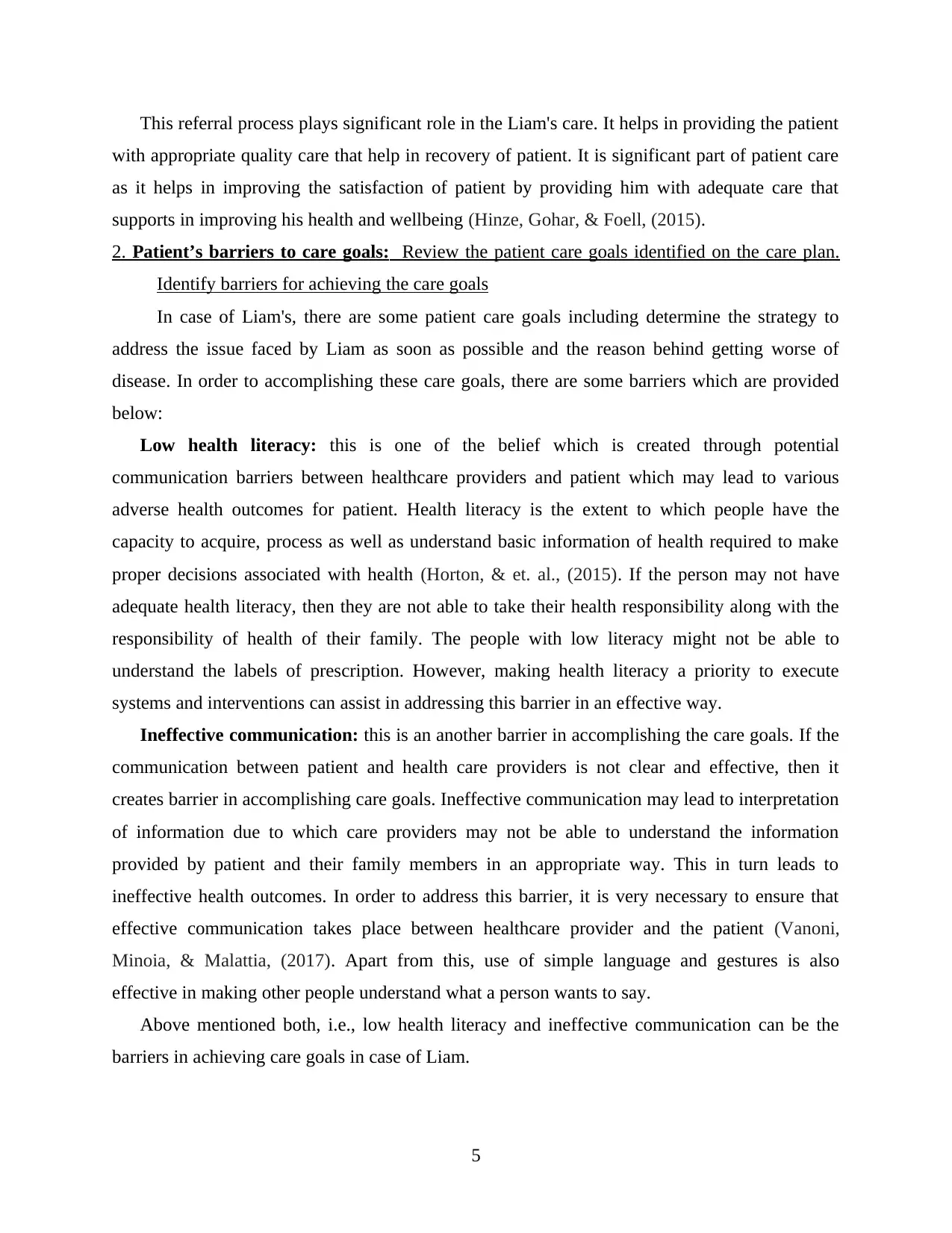
This referral process plays significant role in the Liam's care. It helps in providing the patient
with appropriate quality care that help in recovery of patient. It is significant part of patient care
as it helps in improving the satisfaction of patient by providing him with adequate care that
supports in improving his health and wellbeing (Hinze, Gohar, & Foell, (2015).
2. Patient’s barriers to care goals: Review the patient care goals identified on the care plan.
Identify barriers for achieving the care goals
In case of Liam's, there are some patient care goals including determine the strategy to
address the issue faced by Liam as soon as possible and the reason behind getting worse of
disease. In order to accomplishing these care goals, there are some barriers which are provided
below:
Low health literacy: this is one of the belief which is created through potential
communication barriers between healthcare providers and patient which may lead to various
adverse health outcomes for patient. Health literacy is the extent to which people have the
capacity to acquire, process as well as understand basic information of health required to make
proper decisions associated with health (Horton, & et. al., (2015). If the person may not have
adequate health literacy, then they are not able to take their health responsibility along with the
responsibility of health of their family. The people with low literacy might not be able to
understand the labels of prescription. However, making health literacy a priority to execute
systems and interventions can assist in addressing this barrier in an effective way.
Ineffective communication: this is an another barrier in accomplishing the care goals. If the
communication between patient and health care providers is not clear and effective, then it
creates barrier in accomplishing care goals. Ineffective communication may lead to interpretation
of information due to which care providers may not be able to understand the information
provided by patient and their family members in an appropriate way. This in turn leads to
ineffective health outcomes. In order to address this barrier, it is very necessary to ensure that
effective communication takes place between healthcare provider and the patient (Vanoni,
Minoia, & Malattia, (2017). Apart from this, use of simple language and gestures is also
effective in making other people understand what a person wants to say.
Above mentioned both, i.e., low health literacy and ineffective communication can be the
barriers in achieving care goals in case of Liam.
5
with appropriate quality care that help in recovery of patient. It is significant part of patient care
as it helps in improving the satisfaction of patient by providing him with adequate care that
supports in improving his health and wellbeing (Hinze, Gohar, & Foell, (2015).
2. Patient’s barriers to care goals: Review the patient care goals identified on the care plan.
Identify barriers for achieving the care goals
In case of Liam's, there are some patient care goals including determine the strategy to
address the issue faced by Liam as soon as possible and the reason behind getting worse of
disease. In order to accomplishing these care goals, there are some barriers which are provided
below:
Low health literacy: this is one of the belief which is created through potential
communication barriers between healthcare providers and patient which may lead to various
adverse health outcomes for patient. Health literacy is the extent to which people have the
capacity to acquire, process as well as understand basic information of health required to make
proper decisions associated with health (Horton, & et. al., (2015). If the person may not have
adequate health literacy, then they are not able to take their health responsibility along with the
responsibility of health of their family. The people with low literacy might not be able to
understand the labels of prescription. However, making health literacy a priority to execute
systems and interventions can assist in addressing this barrier in an effective way.
Ineffective communication: this is an another barrier in accomplishing the care goals. If the
communication between patient and health care providers is not clear and effective, then it
creates barrier in accomplishing care goals. Ineffective communication may lead to interpretation
of information due to which care providers may not be able to understand the information
provided by patient and their family members in an appropriate way. This in turn leads to
ineffective health outcomes. In order to address this barrier, it is very necessary to ensure that
effective communication takes place between healthcare provider and the patient (Vanoni,
Minoia, & Malattia, (2017). Apart from this, use of simple language and gestures is also
effective in making other people understand what a person wants to say.
Above mentioned both, i.e., low health literacy and ineffective communication can be the
barriers in achieving care goals in case of Liam.
5
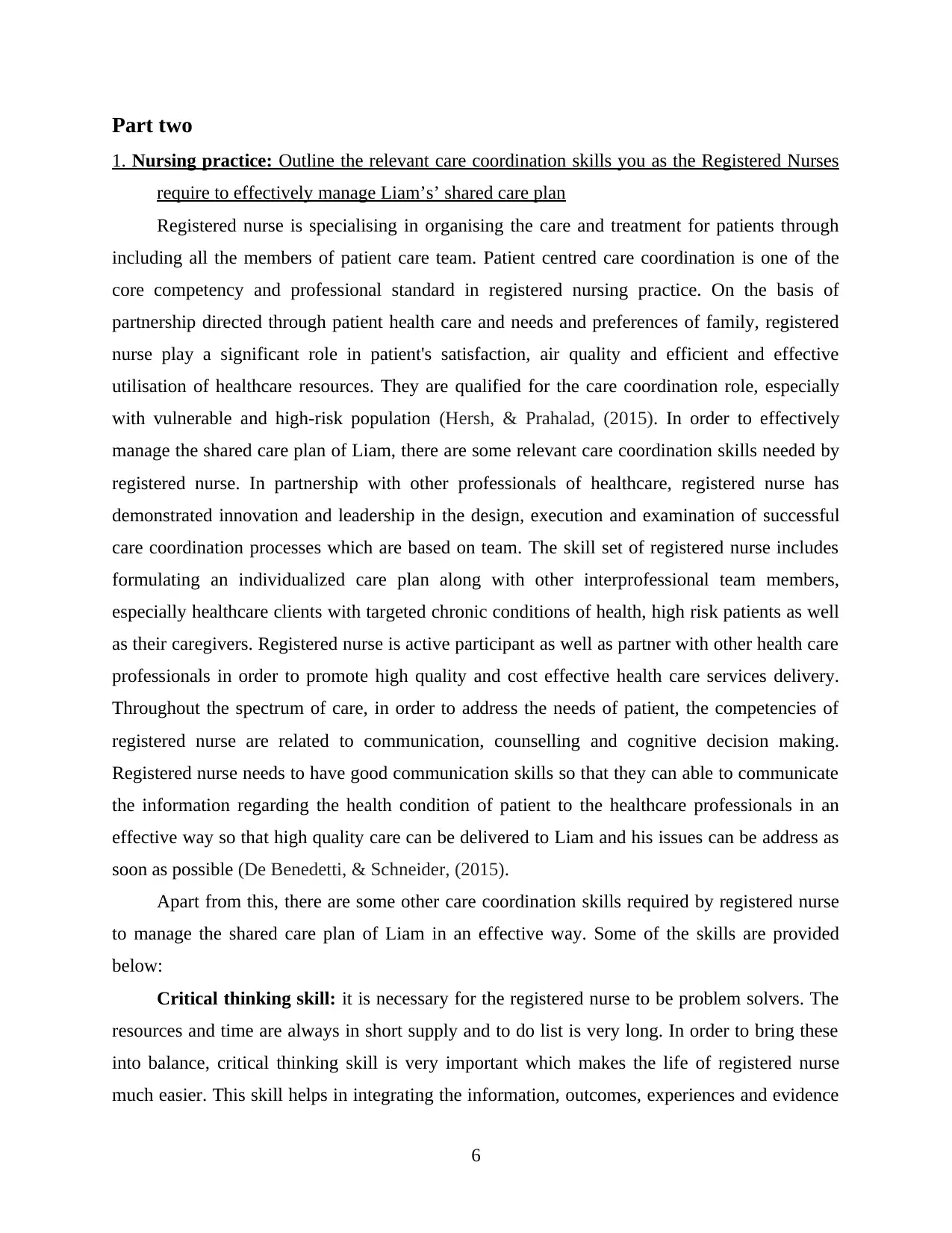
Part two
1. Nursing practice: Outline the relevant care coordination skills you as the Registered Nurses
require to effectively manage Liam’s’ shared care plan
Registered nurse is specialising in organising the care and treatment for patients through
including all the members of patient care team. Patient centred care coordination is one of the
core competency and professional standard in registered nursing practice. On the basis of
partnership directed through patient health care and needs and preferences of family, registered
nurse play a significant role in patient's satisfaction, air quality and efficient and effective
utilisation of healthcare resources. They are qualified for the care coordination role, especially
with vulnerable and high-risk population (Hersh, & Prahalad, (2015). In order to effectively
manage the shared care plan of Liam, there are some relevant care coordination skills needed by
registered nurse. In partnership with other professionals of healthcare, registered nurse has
demonstrated innovation and leadership in the design, execution and examination of successful
care coordination processes which are based on team. The skill set of registered nurse includes
formulating an individualized care plan along with other interprofessional team members,
especially healthcare clients with targeted chronic conditions of health, high risk patients as well
as their caregivers. Registered nurse is active participant as well as partner with other health care
professionals in order to promote high quality and cost effective health care services delivery.
Throughout the spectrum of care, in order to address the needs of patient, the competencies of
registered nurse are related to communication, counselling and cognitive decision making.
Registered nurse needs to have good communication skills so that they can able to communicate
the information regarding the health condition of patient to the healthcare professionals in an
effective way so that high quality care can be delivered to Liam and his issues can be address as
soon as possible (De Benedetti, & Schneider, (2015).
Apart from this, there are some other care coordination skills required by registered nurse
to manage the shared care plan of Liam in an effective way. Some of the skills are provided
below:
Critical thinking skill: it is necessary for the registered nurse to be problem solvers. The
resources and time are always in short supply and to do list is very long. In order to bring these
into balance, critical thinking skill is very important which makes the life of registered nurse
much easier. This skill helps in integrating the information, outcomes, experiences and evidence
6
1. Nursing practice: Outline the relevant care coordination skills you as the Registered Nurses
require to effectively manage Liam’s’ shared care plan
Registered nurse is specialising in organising the care and treatment for patients through
including all the members of patient care team. Patient centred care coordination is one of the
core competency and professional standard in registered nursing practice. On the basis of
partnership directed through patient health care and needs and preferences of family, registered
nurse play a significant role in patient's satisfaction, air quality and efficient and effective
utilisation of healthcare resources. They are qualified for the care coordination role, especially
with vulnerable and high-risk population (Hersh, & Prahalad, (2015). In order to effectively
manage the shared care plan of Liam, there are some relevant care coordination skills needed by
registered nurse. In partnership with other professionals of healthcare, registered nurse has
demonstrated innovation and leadership in the design, execution and examination of successful
care coordination processes which are based on team. The skill set of registered nurse includes
formulating an individualized care plan along with other interprofessional team members,
especially healthcare clients with targeted chronic conditions of health, high risk patients as well
as their caregivers. Registered nurse is active participant as well as partner with other health care
professionals in order to promote high quality and cost effective health care services delivery.
Throughout the spectrum of care, in order to address the needs of patient, the competencies of
registered nurse are related to communication, counselling and cognitive decision making.
Registered nurse needs to have good communication skills so that they can able to communicate
the information regarding the health condition of patient to the healthcare professionals in an
effective way so that high quality care can be delivered to Liam and his issues can be address as
soon as possible (De Benedetti, & Schneider, (2015).
Apart from this, there are some other care coordination skills required by registered nurse
to manage the shared care plan of Liam in an effective way. Some of the skills are provided
below:
Critical thinking skill: it is necessary for the registered nurse to be problem solvers. The
resources and time are always in short supply and to do list is very long. In order to bring these
into balance, critical thinking skill is very important which makes the life of registered nurse
much easier. This skill helps in integrating the information, outcomes, experiences and evidence
6
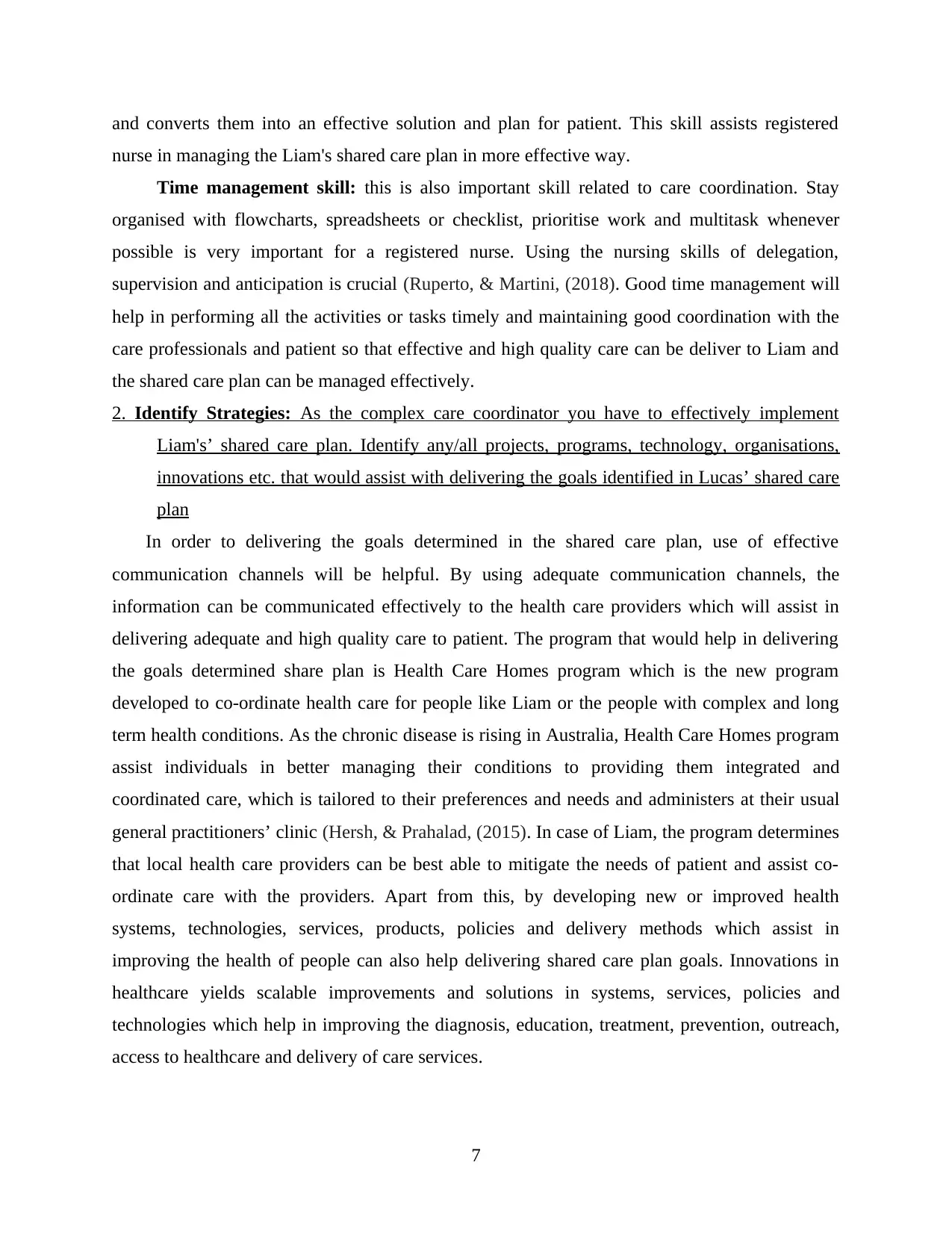
and converts them into an effective solution and plan for patient. This skill assists registered
nurse in managing the Liam's shared care plan in more effective way.
Time management skill: this is also important skill related to care coordination. Stay
organised with flowcharts, spreadsheets or checklist, prioritise work and multitask whenever
possible is very important for a registered nurse. Using the nursing skills of delegation,
supervision and anticipation is crucial (Ruperto, & Martini, (2018). Good time management will
help in performing all the activities or tasks timely and maintaining good coordination with the
care professionals and patient so that effective and high quality care can be deliver to Liam and
the shared care plan can be managed effectively.
2. Identify Strategies: As the complex care coordinator you have to effectively implement
Liam's’ shared care plan. Identify any/all projects, programs, technology, organisations,
innovations etc. that would assist with delivering the goals identified in Lucas’ shared care
plan
In order to delivering the goals determined in the shared care plan, use of effective
communication channels will be helpful. By using adequate communication channels, the
information can be communicated effectively to the health care providers which will assist in
delivering adequate and high quality care to patient. The program that would help in delivering
the goals determined share plan is Health Care Homes program which is the new program
developed to co-ordinate health care for people like Liam or the people with complex and long
term health conditions. As the chronic disease is rising in Australia, Health Care Homes program
assist individuals in better managing their conditions to providing them integrated and
coordinated care, which is tailored to their preferences and needs and administers at their usual
general practitioners’ clinic (Hersh, & Prahalad, (2015). In case of Liam, the program determines
that local health care providers can be best able to mitigate the needs of patient and assist co-
ordinate care with the providers. Apart from this, by developing new or improved health
systems, technologies, services, products, policies and delivery methods which assist in
improving the health of people can also help delivering shared care plan goals. Innovations in
healthcare yields scalable improvements and solutions in systems, services, policies and
technologies which help in improving the diagnosis, education, treatment, prevention, outreach,
access to healthcare and delivery of care services.
7
nurse in managing the Liam's shared care plan in more effective way.
Time management skill: this is also important skill related to care coordination. Stay
organised with flowcharts, spreadsheets or checklist, prioritise work and multitask whenever
possible is very important for a registered nurse. Using the nursing skills of delegation,
supervision and anticipation is crucial (Ruperto, & Martini, (2018). Good time management will
help in performing all the activities or tasks timely and maintaining good coordination with the
care professionals and patient so that effective and high quality care can be deliver to Liam and
the shared care plan can be managed effectively.
2. Identify Strategies: As the complex care coordinator you have to effectively implement
Liam's’ shared care plan. Identify any/all projects, programs, technology, organisations,
innovations etc. that would assist with delivering the goals identified in Lucas’ shared care
plan
In order to delivering the goals determined in the shared care plan, use of effective
communication channels will be helpful. By using adequate communication channels, the
information can be communicated effectively to the health care providers which will assist in
delivering adequate and high quality care to patient. The program that would help in delivering
the goals determined share plan is Health Care Homes program which is the new program
developed to co-ordinate health care for people like Liam or the people with complex and long
term health conditions. As the chronic disease is rising in Australia, Health Care Homes program
assist individuals in better managing their conditions to providing them integrated and
coordinated care, which is tailored to their preferences and needs and administers at their usual
general practitioners’ clinic (Hersh, & Prahalad, (2015). In case of Liam, the program determines
that local health care providers can be best able to mitigate the needs of patient and assist co-
ordinate care with the providers. Apart from this, by developing new or improved health
systems, technologies, services, products, policies and delivery methods which assist in
improving the health of people can also help delivering shared care plan goals. Innovations in
healthcare yields scalable improvements and solutions in systems, services, policies and
technologies which help in improving the diagnosis, education, treatment, prevention, outreach,
access to healthcare and delivery of care services.
7
Paraphrase This Document
Need a fresh take? Get an instant paraphrase of this document with our AI Paraphraser
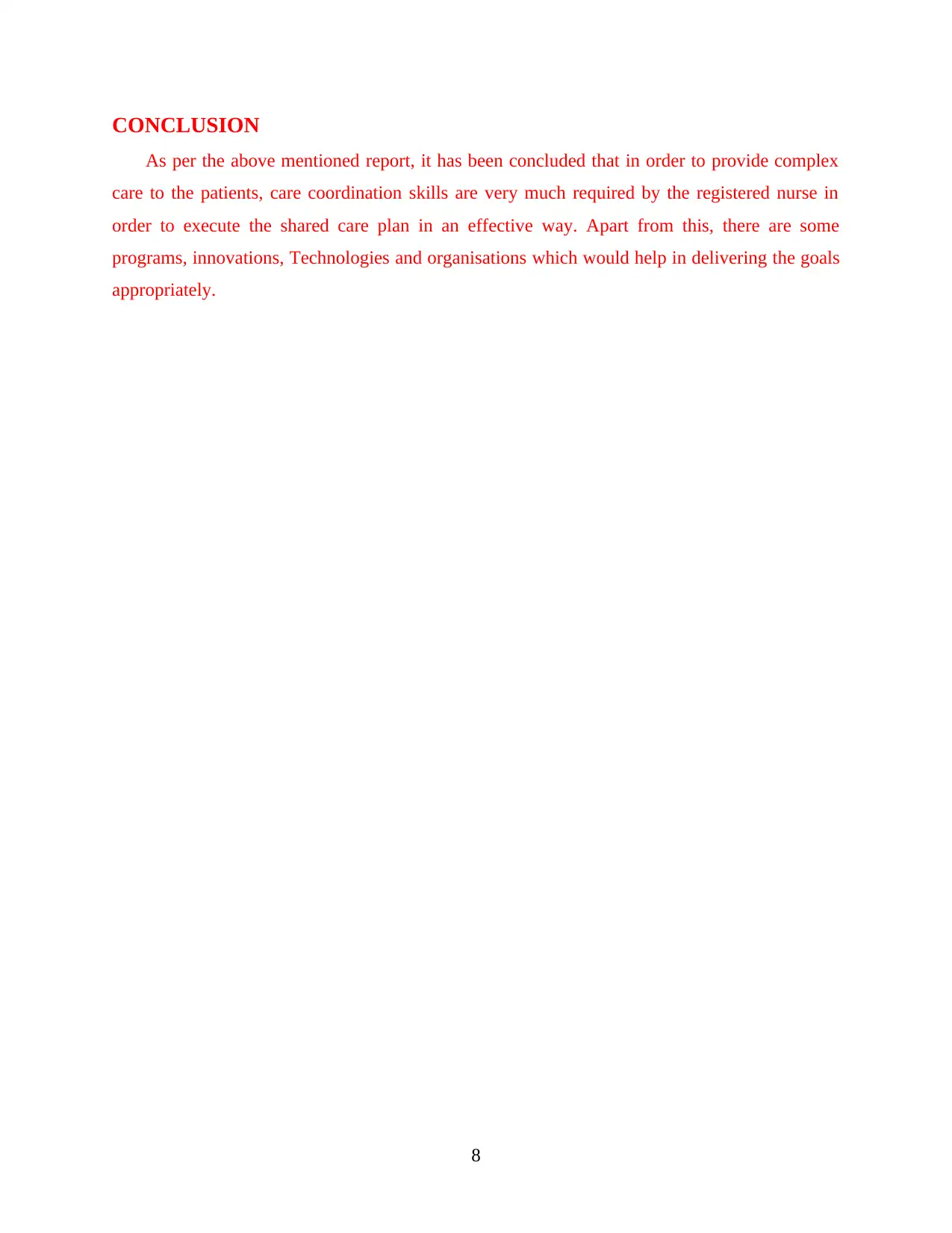
CONCLUSION
As per the above mentioned report, it has been concluded that in order to provide complex
care to the patients, care coordination skills are very much required by the registered nurse in
order to execute the shared care plan in an effective way. Apart from this, there are some
programs, innovations, Technologies and organisations which would help in delivering the goals
appropriately.
8
As per the above mentioned report, it has been concluded that in order to provide complex
care to the patients, care coordination skills are very much required by the registered nurse in
order to execute the shared care plan in an effective way. Apart from this, there are some
programs, innovations, Technologies and organisations which would help in delivering the goals
appropriately.
8
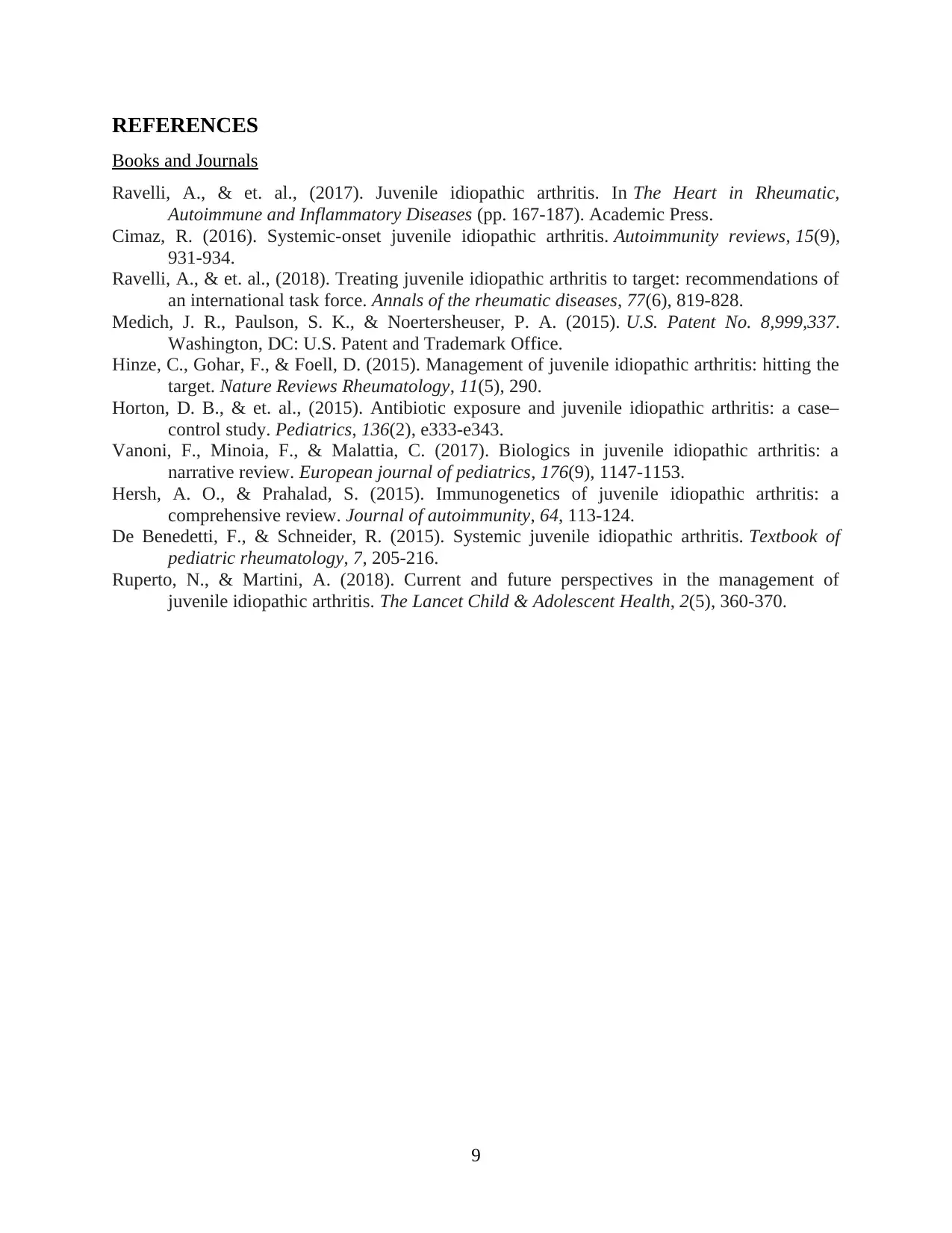
REFERENCES
Books and Journals
Ravelli, A., & et. al., (2017). Juvenile idiopathic arthritis. In The Heart in Rheumatic,
Autoimmune and Inflammatory Diseases (pp. 167-187). Academic Press.
Cimaz, R. (2016). Systemic-onset juvenile idiopathic arthritis. Autoimmunity reviews, 15(9),
931-934.
Ravelli, A., & et. al., (2018). Treating juvenile idiopathic arthritis to target: recommendations of
an international task force. Annals of the rheumatic diseases, 77(6), 819-828.
Medich, J. R., Paulson, S. K., & Noertersheuser, P. A. (2015). U.S. Patent No. 8,999,337.
Washington, DC: U.S. Patent and Trademark Office.
Hinze, C., Gohar, F., & Foell, D. (2015). Management of juvenile idiopathic arthritis: hitting the
target. Nature Reviews Rheumatology, 11(5), 290.
Horton, D. B., & et. al., (2015). Antibiotic exposure and juvenile idiopathic arthritis: a case–
control study. Pediatrics, 136(2), e333-e343.
Vanoni, F., Minoia, F., & Malattia, C. (2017). Biologics in juvenile idiopathic arthritis: a
narrative review. European journal of pediatrics, 176(9), 1147-1153.
Hersh, A. O., & Prahalad, S. (2015). Immunogenetics of juvenile idiopathic arthritis: a
comprehensive review. Journal of autoimmunity, 64, 113-124.
De Benedetti, F., & Schneider, R. (2015). Systemic juvenile idiopathic arthritis. Textbook of
pediatric rheumatology, 7, 205-216.
Ruperto, N., & Martini, A. (2018). Current and future perspectives in the management of
juvenile idiopathic arthritis. The Lancet Child & Adolescent Health, 2(5), 360-370.
9
Books and Journals
Ravelli, A., & et. al., (2017). Juvenile idiopathic arthritis. In The Heart in Rheumatic,
Autoimmune and Inflammatory Diseases (pp. 167-187). Academic Press.
Cimaz, R. (2016). Systemic-onset juvenile idiopathic arthritis. Autoimmunity reviews, 15(9),
931-934.
Ravelli, A., & et. al., (2018). Treating juvenile idiopathic arthritis to target: recommendations of
an international task force. Annals of the rheumatic diseases, 77(6), 819-828.
Medich, J. R., Paulson, S. K., & Noertersheuser, P. A. (2015). U.S. Patent No. 8,999,337.
Washington, DC: U.S. Patent and Trademark Office.
Hinze, C., Gohar, F., & Foell, D. (2015). Management of juvenile idiopathic arthritis: hitting the
target. Nature Reviews Rheumatology, 11(5), 290.
Horton, D. B., & et. al., (2015). Antibiotic exposure and juvenile idiopathic arthritis: a case–
control study. Pediatrics, 136(2), e333-e343.
Vanoni, F., Minoia, F., & Malattia, C. (2017). Biologics in juvenile idiopathic arthritis: a
narrative review. European journal of pediatrics, 176(9), 1147-1153.
Hersh, A. O., & Prahalad, S. (2015). Immunogenetics of juvenile idiopathic arthritis: a
comprehensive review. Journal of autoimmunity, 64, 113-124.
De Benedetti, F., & Schneider, R. (2015). Systemic juvenile idiopathic arthritis. Textbook of
pediatric rheumatology, 7, 205-216.
Ruperto, N., & Martini, A. (2018). Current and future perspectives in the management of
juvenile idiopathic arthritis. The Lancet Child & Adolescent Health, 2(5), 360-370.
9
1 out of 9
Related Documents
Your All-in-One AI-Powered Toolkit for Academic Success.
+13062052269
info@desklib.com
Available 24*7 on WhatsApp / Email
![[object Object]](/_next/static/media/star-bottom.7253800d.svg)
Unlock your academic potential
© 2024 | Zucol Services PVT LTD | All rights reserved.




